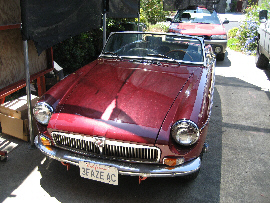Silicon Productions 

The MGB Electric Sports Car
Analysis by Warren Winovich
Page 5
By the mathematical expediant of differentiating the velocity expression, the general solution for acceleration is obtained.
a = 4(Vf/c) x [(e2t/c)/(1 + e2t/c)2 ]
The initial rate of acceleration (t= 0) is determined by the final velocity (i.e., top speed) and the time constant of the vehicle.
a0 = Vf/c
When the initial rate of the acceleration of the vehicle is known, the time constant of the vehicle is determined. Initial rate of acceleration is readily found from the initial G-force as determined by starting torque and driving weight - mainly. The initial forces acting on a vehicle (at the starting) give the initial G-force:
Go = (Ts/W x R) - r0, #/lbm
The starting torque is that of the motor increased by the overall gear ratio of the drivetrain. The weight term includes the driver and passengers; and the value of "R" here is the radius of the tire/wheel combination as given in the list of specifications. The rolling force term, r0, is the value for zero ( or very low) velocity. Note that with modern tires of radial design with low aspect ratio the initial rolling force is small - 0.0075 #/lbm, for example.
Calculation of the acceleration for the MGB electric sports car.
Go = [(14 x 3 x 8)/2700 x 0.958)] – 0.0075 = 0.1224 #/lbm
ao = Go x gc = 0.1224 x 32.174 = 3.938 ft/sec2
c = Vf/ao = (80.667, ft/sec)/(3.938, ft/sec2) = 20.484 seconds
The velocity of the MGB electric sports car, then, becomes:
V/Vf = 1 - 2/(1 +e2t/20.484). where Vf = 55 mph
In figure 7, velocity is shown as a function of time for the MGB electric sports car. Distance traveled during the acceleration is also shown; distance is found by the mathematical process of integration of the velocity function.
Time to reach 30 mph, for city driving, say, is 12.534 seconds; and the time to attain a highway cruise velocity of 50 mph is calculated as 31.182 seconds. For distance traveled: 1/8-mi: 19.548s @40.80 mph; 1/4-mi: 29.437s @ 49.12 mph.
The relations shown above allow for the calculaiton of the velocity and distance travelled as the MGB accelerates. Modern inverter/controllers - such as the Curtis 1238 - are programmable to develop maximum starting torques over extended motor speeds. This is accomplished by maintaining the ratio of impressed voltage to frequency constant. The ratio can be held constant for motor speeds up to 1/3 to 1/2 of the synchronous speed. Thereafter, motor torque decreases and subsequently falls rapidly to the lower torque requirement for steady-speed operation. The torque/speed relation for the modern inverter/controller is represented by :
T/Ts = 1 - (S/N)5
This relation establishes the ratio of the starting torque to torque at peak power as Ts/Tpp - 1.2 (See appendix 2 for a development for the torque/speed relation)
For the peak-power rating of 30kW, starting torque is found as 54 foot-pounds. Then the initial G-Force and related acceleration parameters follow directly.
Go = (54 x 8)/(2700 x 0.958) - 0.0075 = 0.1595 #/lbm
[ The 8 is the gearing ratio (motor to wheel), 2700 is the vehicle weight, the 0.958 is the wheel radius in feet and the 0.0075 is the static force required to get the car moving]
ao = Go x gc = 0.1595 x 32.174 = 5.13 ft/sec2
[ The above equation reads 'The car experiences a force Go applied and therefore the car experiences a "proper acceleration" of Go of the gravitational constant']
[ The vehicle time constant, 'c' ]
c = Vf/ao = 79.82/5.13 = 15.559 seconds
The velocity expression for the MGB during acceleration is:
V/Vf = 1 - 2/(1 + e2t/15.559); Vf : 54.42 mph = 79.82 ft/sec
Acceleration in terms of velocity and distance travelled is shown in figure 7. Time to 30 mph: 9.650 seconds; and to 50 mph: 24.601 seconds. Quarter-mile: 26.835 seconds @ 51.07 mph.
Page 5
Start Previous Page Next Page
Page 1 2 3 4 5 6 7 8 9 10 11 12 13 14 15 16